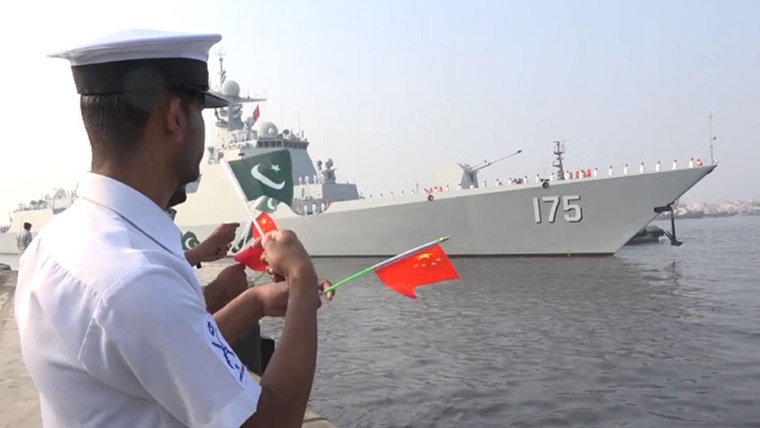
BEIJING – Navies of China and Pakistan, holding nine-day exercises in the Arabian Sea to enhance their all-weather strategic partnership, have for the first-time deployed submarines, providing a rare major exposure to the Chinese navy in the region.
The Arabian Sea region is strategically important for India as major ports including Kandla, Okha , Mumbai, Nhava Sheva (Navi Mumbai), Mormug o, New Mangalore, and Kochi are located there.
The joint maritime exercises began on Monday in the North Arabian Sea, regarded strategically significant for China which is now developing Pakistan’s deep water Gwadar port there.
Gwadar is being connected through the over USD 60 billion China Pakistan Economic Corridor (CPEC) to China’s Xinjiang province, providing a key land route to China to access the warm waters of Arabian Sea. India has objected to China over the CPEC as it is being laid through the Pakistan-occupied Kashmir (PoK).
The Gwadar is also located close to Iran’s Chabahar Port being jointly developed by Iran, India and Afghanistan to ensure a trade corridor for Indian exports to Afghanistan.
The Arabian Sea provides entry to the Indian Ocean where China currently has built a logistics base at Djibouti in the Horn of Africa.
The joint exercises are expected to be the first of many to come, as China and Pakistan have now developed a series of joint exercises covering the navy, army and air force, the PLA (People’s Liberation Army) Daily, the official newspaper of the Chinese military, reported.
The report said that this joint exercise is not related to ongoing regional affairs and is not aimed at any third party.
The exercise is also the first between China and Pakistan that will feature anti-submarine and submarine rescue training, indicating a high-level of strategic mutual trust, state-run Global Times quoted experts as saying.
The exercise started on Monday in the port city of Karachi, Pakistan, and will be held in the North Arabian Sea until January 14, the PLA Daily reported on Tuesday.
This is the sixth joint naval exercise between China and Pakistan, the report said, but it is the first time the exercise was named “Sea Guardians.”
“Sea Guardians” is expected to become a series of naval exercises with Pakistan, similar to the “Warrior” series of joint land exercises and the “Shaheen” series of joint air exercises, the report said.
Zhang Junshe, a senior research fellow at the PLA Naval Military Studies Research Institute, told the Global Times that serialising the drills and making them a routine will further enhance China and Pakistan’s friendship and cooperation.
The Chinese troops mainly come from the People’s Liberation Army (PLA) Southern Theater Command Navy, including the guided missile destroyer Yinchuan, guided missile frigate Yuncheng, comprehensive supply ship Weishanhu, submarine rescue ship Liugongdao, two ship-based helicopters and some 60 Chinese Marines, the PLA Daily reported.
Pakistan deployed two frigates, two missile boats, a fixed-wing anti-submarine aircraft, two vessel-based helicopters and about 60 members of special forces participating in the drills.
The drills would focus on joint cruising, air defence, maritime interception, anti-submarine and live-fire exercises at sea.
Zhou Hanwen, an executive director of the exercise, said that previous China-Pakistan joint naval exercises did not feature anti-submarine and submarine rescue training, and the exercise this time will enhance the two countries’ capability of dealing with underwater threats, China Central Television reported.
Zhang said that the training involving submarine will boost the two navies’ combat capabilities and show a high level of strategic mutual trust.
The goal of the Sea Guardians-2020 drills is to boost the two countries’ military cooperation, enhance their all-weather strategic cooperative partnership, build a safe maritime environment and enhance the two navies’ capability to deal with maritime terrorism and crime, the PLA Daily report said.
Follow this link to join our WhatsApp group: Join Now
Be Part of Quality Journalism |
Quality journalism takes a lot of time, money and hard work to produce and despite all the hardships we still do it. Our reporters and editors are working overtime in Kashmir and beyond to cover what you care about, break big stories, and expose injustices that can change lives. Today more people are reading Kashmir Observer than ever, but only a handful are paying while advertising revenues are falling fast. |
| ACT NOW |
| MONTHLY | Rs 100 | |
| YEARLY | Rs 1000 | |
| LIFETIME | Rs 10000 | |









